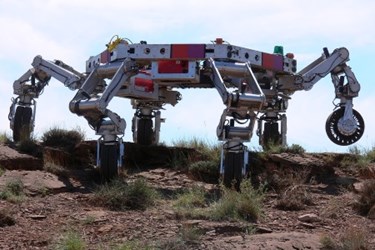Can Robot Control Theory Improve Prosthetic Performance?
By Chuck Seegert, Ph.D.

By applying robot control theory, powered prosthetics have been modified to dynamically respond to an environment during walking. When wearing these robotic legs, amputees can walk nearly as fast as able-bodied people on a treadmill.
Existing prosthetics can limit certain activities in humans, which seems odd in an age when robots can walk, run, jump, and even climb stairs without assistance. Prosthetics have gotten lighter and improved in flexibility, but generally they do not generate powered movements like those made by the muscles of an able-bodied person. In attempts to remedy this, powered prosthetics have been developed, but often they do not intelligently respond to the uneven terrain a wearer might encounter.
To overcome these issues, Dr. Robert Gregg from the Erik Jonsson School of Engineering and Computer Science at the University of Texas at Dallas (UT Dallas) decided to apply robot control theory to powered prosthetics, according to a recent press release from the UT Dallas News Center.
“We borrowed from robot control theory to create a simple, effective new way to analyze the human gait cycle,” Gregg said in the press release.
To make this advance, Gregg’s analysis led to a simplification of the gait cycle, a notoriously complex phenomenon, according to the press release. Instead of trying to replicate all the interactions of the muscles and joint angles as they exist in nature, the focus was reduced to a single variable, the center of pressure on the foot. Using this variable, the control system in the prosthetic understands where the wearer is at any time during the cycle and can adjust accordingly. This helps amputees achieve a more stable and natural type of walking.
The testing of Gregg’s theory was first undertaken using a computer simulation that studied partial feedback linearization for clinically relevant conditions, according to a study published in IEEE Xplore. Once the design had been refined, it was taken into testing with a set of three actual amputees who used mid-femoral prostheses. The prostheses were configured for each user’s height, weight, and other features in about 15 minutes. Once they were prepared, the subjects walked around to familiarize themselves with the prostheses. Eventually, the prostheses were tested on a treadmill, which operated at increasing speeds.
“We did not tell the prosthesis that the treadmill speed was increasing”, Gregg said in the press release. “The prosthesis responded naturally just as the biological leg would do.”
Prosthetic wearers were able to achieve speeds of over 1 meter/second, which approaches the average walking speed of able-bodied people, which is about 1.3 meters per second, according to the press release.
Robotic control systems are currently the focus of intense levels of research. Like the robotic control systems discussed here, brain machine interfaces that use thoughts to control robotic prostheses are also rapidly advancing.
